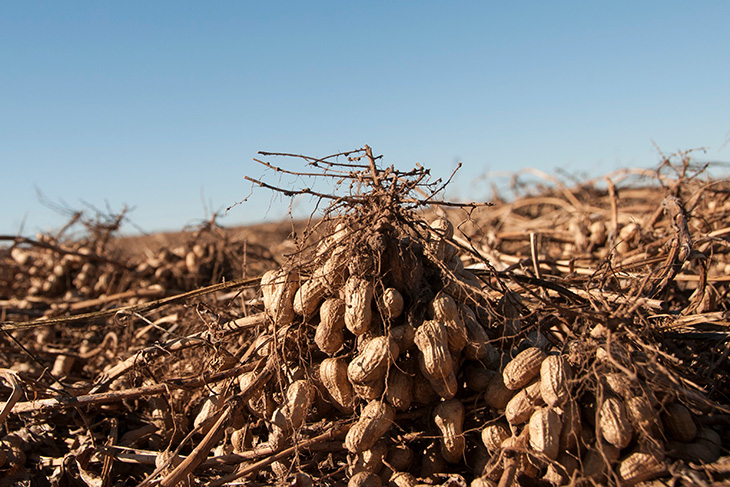
The One Big Beautiful Bill (OBBB) Act, signed into law on July 4, 2025, introduces new opportunities for U.S. peanut producers to manage risk. This article explores the current crop insurance options available to peanut farmers and highlights how the new law expands these choices beginning crop year 2026. Under the OBBB, peanut producers continue to have access to traditional deep-loss and shallow-loss programs, while also gaining access to a new combination of income protection tools: the Supplemental Coverage Option (SCO) and Agriculture Risk Coverage – County (ARC-CO). These programs are designed to help farmers safeguard their income against unexpected losses. This article provides a detailed look at these options and how they can benefit peanut producers.
Deep Loss Programs protect against significant losses, including complete crop losses. The Federal Crop Insurance Program (FCIP) for peanuts offers three farm-level insurance plans that fall into this category. These plans form the foundation of a peanut producer’s risk management strategy. They are also referred to as the underlying policy that peanut producers can purchase to protect against potential losses. (1) Yield Protection (YP) insures against losses when yield falls below a selected coverage level due to natural disasters or other covered events. (2) Revenue Protection (RP) safeguards revenue when it falls below the selected revenue coverage level, either due to low yields, declining prices, or both. (3) Revenue Protection with Harvest Price Exclusion (RP-HPE) functions similarly to RP but does not increase the revenue guarantee if harvest prices rise above the projected price. This typically results in lower premium costs for producers.
Shallow Loss Programs provide additional coverage for smaller, more frequent losses that can impact a farmer’s income. For peanut producers, shallow loss insurance options include SCO and the Enhanced Coverage Option (ECO). These are add-ons, not standalone policies, and must be paired with an underlying policy, such as YP, RP, or RP-HPE. By layering SCO and/or ECO onto their base policy, producers can often achieve higher overall coverage at a lower combined premium than by raising the base policy’s coverage level alone. This layered approach, which combines shallow-loss and deep-loss tools, is explored here by Biram and Connor (2023), who demonstrate that strategic combinations can enhance overall risk protection.
Unlike deep loss programs, which provide protection at the farm level, shallow loss programs do not cover complete crop failures. SCO and ECO are both area-based programs, triggered by county-level yield or revenue outcomes depending on the underlying policy. They help fill the “deductible gap”, covering losses that fall between the individual coverage level of the underlying policy and the higher coverage level selected for SCO or ECO. Biram (2024) discusses how ECO may provide meaningful protection in years when county yields are strong, but market prices decline, offering producers an effective tool to manage upside yield risk and downside price exposure.
Beginning crop year 2026, under the OBBB, producers can now purchase SCO regardless of whether their base acres are enrolled in ARC-CO, removing a major restriction from previous farm bills. This means that the same acres can now be enrolled in both the ARC-CO and SCO programs. Additionally, the maximum SCO coverage level was increased to 90%, and its premium subsidy rate was raised to 80% (Biram & Maples, 2025). RMA has issued guidance on implementing the legislative changes. Under this new guidance[1], the 80% higher premium subsidy rate will also extend to the Enhanced Coverage Option (ECO) and the Hurricane Insurance Protection–Wind Index (HIP-WI).
Additional Program: In addition to the deep and shallow loss programs, peanut producers can also purchase Hurricane Insurance Protection – Wind Index (HIP-WI). This endorsement helps cover part of the deductible from the primary crop insurance policy when sustained hurricane-force winds impact the county or a neighboring one. HIP-WI can be combined with SCO and ECO, but only if the acreage is already insured under an underlying policy (YP, RP, or RP-HPE). HIP-WI has gained popularity, particularly in regions prone to hurricanes and tropical storms.
Understanding these insurance options empowers farmers to develop customized risk management strategies. By combining standalone policies with supplemental options and endorsements, producers can strengthen their financial resilience against both major and minor losses. For more information, producers are encouraged to visit the U.S. Department of Agriculture’s Risk Management Agency website and use the Agent Locator Tool to connect with a certified crop insurance professional.
Table 1. Individual and Area Crop Insurance Products with Associated Indemnity Triggers and Standalone Status for Peanuts
| Product | Type | Trigger | Standalone |
| Deep Loss Programs | |||
| Yield Protection (YP) | Individual | Farm Yield | Yes |
| Revenue Protection (RP) | Individual | Farm Revenue | Yes |
| Revenue Protection, Harvest Price Exclusion (RP-HPE) | Individual | Farm Revenue | Yes |
| Shallow Loss Programs | |||
| Supplemental Coverage Option (SCO) | Area | County Yield or County Revenue | No |
| Enhanced Coverage Option (ECO) | Area | County Yield or County Revenue | No |
| Additional Program | |||
| Hurricane Insurance Protection – Wind Index (HIP-WI) | Area | Hurricane or Tropical Storm | No |
[1] Starting in 2027, RMA will increase the maximum SCO coverage level from 86% to 90%. For 2026, producers can use ECO to cover that band instead and will receive the same 80% premium subsidy that applies to SCO.
Article courtesy of Southern Ag today: Kalli, Susmitha, Yangxuan Liu, Hunter D. Biram, and Fayu Chong. “Peanut Crop Insurance: What’s Available and What’s New Under the OBBB Act.” Southern Ag Today 5(44.1). October 27, 2025. Permalink

















